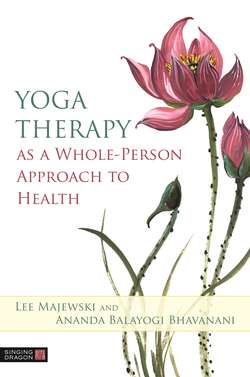Читать книгу Yoga Therapy as a Whole-Person Approach to Health - Lee Majewski - Страница 25
На сайте Литреса книга снята с продажи.
Annamaya kosha
ОглавлениеThe word anna indicates nourishing substances that enable survival at the physical level. Gross matter is something we can experience, see, and feel with our five senses. Our body is made out of cells, different tissues, bones, and muscles, and all of these need to be taken care of with a supply of energy and nutrients through eating, digestion, movements or exercise, cleansing, and giving the body rest. On this level we give importance to what is described in the texts about cleanliness of our body from inside and outside, eating appropriately, using our muscles in a good way, and having proper rest and sleep.
From the yogic viewpoint of disease, psychosomatic, stress-related disorders appear to progress through four distinct phases. These can be understood as follows:3
• Psychic: This phase is marked by mild but persistent psychological and behavioral symptoms of stress such as irritability, disturbed sleep, and other minor symptoms. It can be correlated with the intellectual (vijnamaya) and psychological (manomaya) aspects of one’s existence, and yoga as a therapy can be very effective in this phase.
• Psychosomatic: If the stress continues, there is an increase in symptoms, along with the appearance of generalized physiological symptoms such as occasional hypertension or tremors. This phase can be correlated with the psychological (manomaya) and functional-physiological (pranamaya) aspects of one’s existence, and once again, yoga as a therapy can prove very effective in this phase.
• Somatic: This phase is marked by disturbed function of organs, particularly the target, or involved, organ. At this stage the diseased state can begin to be identified. This phase can be correlated with the anatomical-physical (annamaya) and functional-physiological (pranamaya) aspects of one’s existence. Yoga as a therapy is less effective in this phase, and may need to be used in conjunction with other methods of treatment.
• Organic: This phase is marked by full manifestation of the diseased state, with pathological changes such as an ulcerated stomach or chronic hypertension becoming manifest in their totality with their resultant complications. This phase can be correlated with the anatomical-physical (annamaya) existence as the disease has become fixed in the physical body. This is similar to the modern medical concept of target organ damage (TOD), and yoga as a therapy has a palliative and quality of life-improving effect in this phase. It also produces positive emotional and psychological effects, even in terminal and end of life situations. However, the early stages of the disease process are often overlooked, and the final stage is seen as an entity unto itself, having little relationship to one’s living and thinking habits and patterns. This is because modern medicine only looks at the physical aspects and neglects the influence of existential (pancha kosha) and subtle manifestations (trisharira) on health and disease.
Yoga as a therapy works very well at both the psychic and psychosomatic stages. Once the disease enters the somatic stage, yoga therapy as an adjunct to other therapies may improve the condition. In the organic stage, yoga therapy’s role is more of a palliative, pain-relieving, and rehabilitative nature.
The modern world is facing a pandemic of lifestyle disorders that require changes to be made consciously by individuals themselves. Yoga places great importance on a proper and healthy lifestyle, whose main components are:
• Achar: Yoga stresses the importance of healthy activities such as exercise, and recommends body–breath work (asana, pranayama, kriya) on a regular basis. Improved cardiorespiratory health, exercise tolerance, agility, and physical endurance are by-products of such healthy activities.
• Vichar: Healthy thoughts and a healthy attitude towards life are vital for wellbeing. A balanced state of mind is obtained by following moral self-restraints (yama) and ethical observances (niyama). As Mahatma Gandhi said, “The world has enough in this world for everyone’s needs, but not enough for everyone’s greed.”
• Ahar: Yoga emphasizes the need for a healthy vegetarian diet that has an adequate intake of fresh water along with a well-balanced intake of fresh food, green salads, sprouts, unrefined cereals, and fresh fruits. It is important to be aware of the need for food to be prepared and served with love and affection (sattvic).
• Vihar: Proper recreational activities to relax the body and mind are essential for good health. This includes proper relaxation, maintaining quietude of action-speech-thoughts, and group activities wherein one loses the sense of individuality. Serving others in a selfless manner (Karma Yoga) is an excellent way to achieve inner peace and joy.
• Vyavahar: Healthy interpersonal relationships that enable us to be the best “we” can be, learning to adapt to other people in our life and create a sense of teamwork, enabling the sublimation of the ego into a positive energy that sustains relationships rather than harms them. When we learn to live with gratitude, respect, love, and acceptance, life becomes much better, and we grow as individuals.
